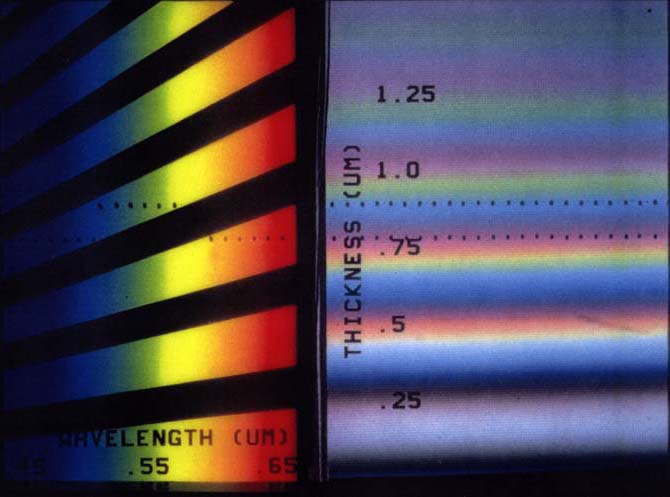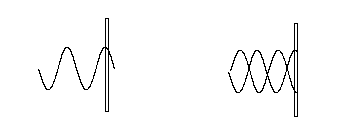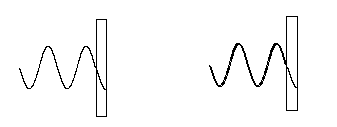
This will color your thoughts
Introduction
A color figure will help you understand the colors you see in a soap
film.
Material
The color image below
A ruler

To Do and Notice
If you have not studied the colors in a soap film do the Soap
film in a can activity first.
To Understand the reflected waves better do the Soap
Film Interference activity.
Look at the color image above.
Notice that along the right edge appear the colors that you see in a
soap film. The colors have been scanned into a computer from a color
photograph of an actual soap film. However the soap film has been
turned upside down so that the thinnest part of the soap film is at
the bottom. Real soap films are thinner at the top because the water
drains down out of them due to gravity.
Notice that the image of the soap film is black at the bottom
where the soap film is thinnest, much thinner than a wavelength of
light. As you examine higher portions of the soap film it becomes
thicker. To the left of each color is printed the thickness of the
soap film in micrometers (millionths of a meter.) which produces that
color.
To understand how these colors are produced look to the left of
the soap film colors. You will see a spectrum of light arranged by
wavelength with violet at the left and red at the right. The spectrum
is crossed by diagonal black bands.
To find the color of the soap film place a ruler horizontally across
the banded spectrum so that the ruler crosses the color you wish to
understand. The color of the soap film is the sum of all the colors
crossed by the ruler. For example, the color of a soap film of
thickness 0.80 micrometers (indicated by the lower horizontal dotted
line) is magenta, at this thickness the black band removes green
light from the spectrum, the remaining blue and red colors add to
produce magenta. At a thickness of 0.9 micrometers the soap film is
cyan. Two different black bands have removed the red and a portion of
the blue light.
What’s Going On?
A thin soap film is black (transparent)
The light that reflects from a soap film is the sum of the light
that reflects from the front of the film and from the back of the
film. When the soap film is much thinner than a wavelength of any
color of visible light the light reflecting from the front and the
back cancel each other for all wavelengths. When light reflects while
going from air to water its wave is inverted, while it reflects while
going from water to air it is not inverted. A light wave and its
inverse cancel each other. As a result thin films reflect no light
and so are transparent. Against a black background they look black. A
ruler placed across the black band at the bottom of the figure
touches no colors, so the sum of all colors touched by the ruler is
black.

A light wave hits a thin bubble film. The wave
reflects from both Some of the light goes through the bubble.
surfaces. The reflections cancel.
A 200 nm thick soap film is orange
When a soap film is 1/2 as thick as a given wavelength of light,
that wavelength of light will not reflect from the soap film, see
Soap Bubbles. This is a combination of the inversion of the
light wave at the front of the bubble and the extra full wavelength
the light travels through the bubble to the back plus its return to
the front. So when the soap bubble thickens to .20 micrometers, 1/2 a
wavelength of blue light in soap, the soap film will not reflect blue
light. It will reflect other colors however, these colors add to
produce a pastel orange color. A 0.2 micrometer thick soap film is
1/4 of a wavelength of red light thick, red light reflected from
front and back surfaces of the soap film adds up in-phase and is
brightly reflected.

blue light of wavelength 400 nm hits a soap film
200 nm thick. The reflections off the front and the back cancel.
A 100 nm thick soap film is bluish silver
A soap film that is 0.1 micrometers thick is 1/4 of a blue
wavelength thick. At this thickness the reflected blue light from the
front and back surfaces adds up in-phase and the blue is strongly
reflected. All other colors are also reflected, although somewhat
more weakly. The sum of all reflected colors is whitish.

Light hits a soap film The reflections from the
front and rear
that is 1/4 wavelength thick. surfaces add up in-phase.
A soap film that is 1/2 of a wavelength of red light thick does
not reflect red light.
In fact a soap film whose thickness is 1/2 of the wavelength
corresponding to any color of light does not reflect that color.
Since red light has a longer wavelength than blue light a black band
stretches across the spectrum showing the bubble thickness at which
each color is removed.
In fact, at any multiple of 1/2 wavelength of light that color of
light does not reflect from the soap film. These non-reflections are
shown as black bands crossing the spectrum. The colors seen in the
bubbles are made by all of the colors which do reflect from the
bubble film.
Etc
Note, the wavelength of light in the water/bubble solution is actually shorter than the wavelength of light in air. It is shorter by about 40%. This shortening has not been illustrated in the above diagrams. See the Soap Film Interference activity for a longer discussion.
Etc
If you wish to print out just the color image above, it is available by clicking here, go to soap film color image.
|
Scientific Explorations with Paul Doherty |
|
24 May 2000 |